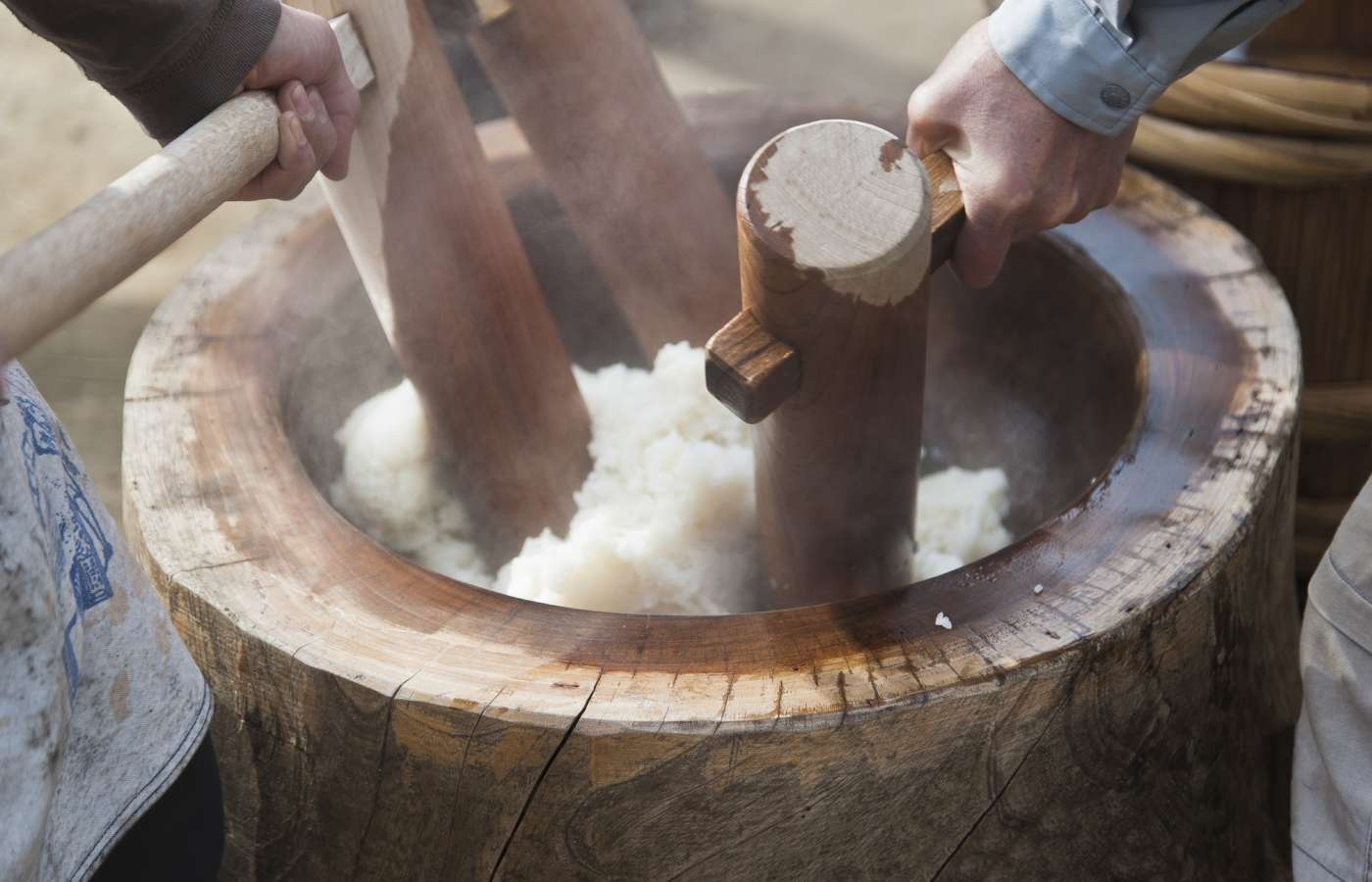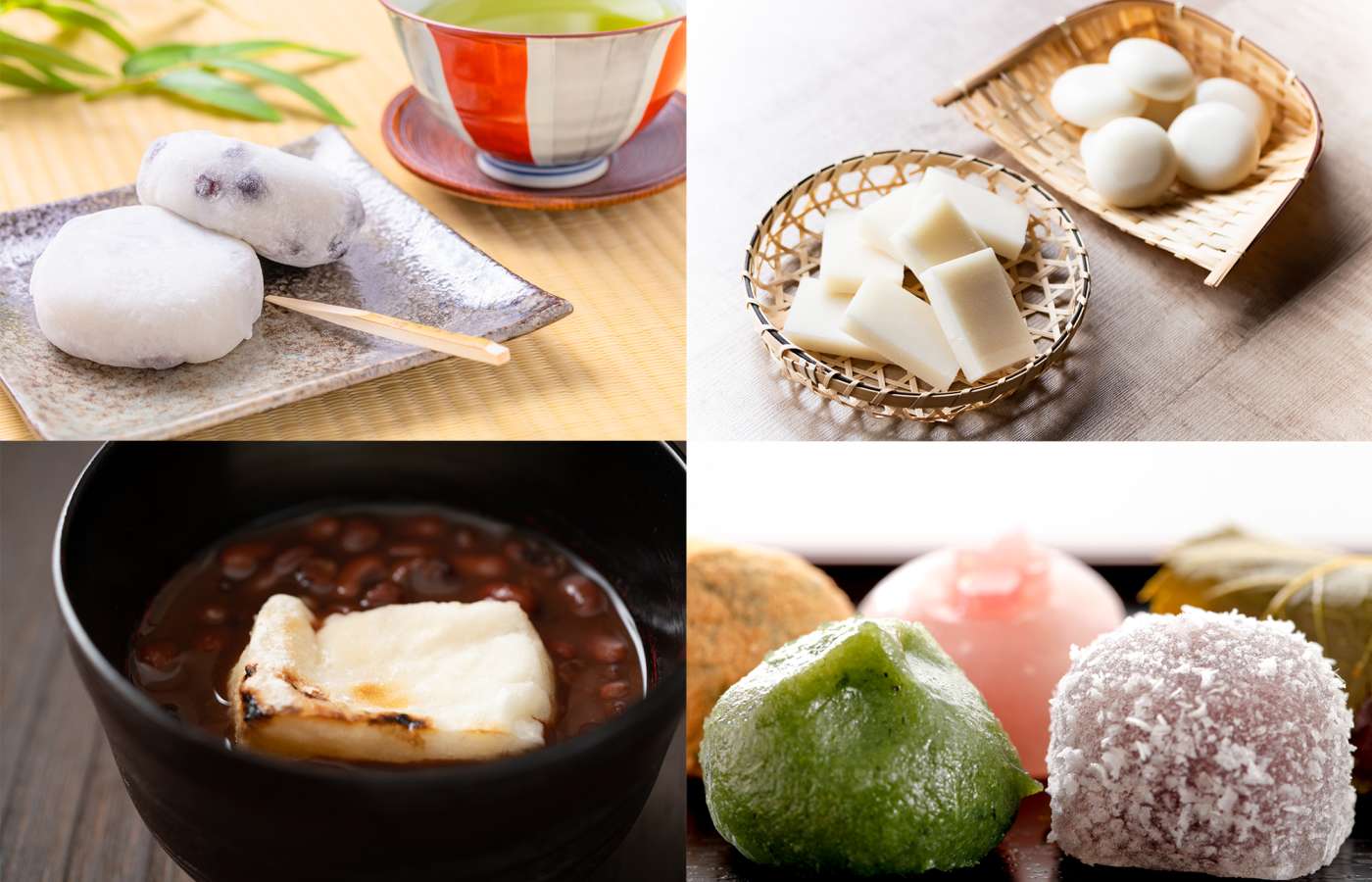
Japanese rice cakes, better known as mochi, have a long cultural history. Let’s take a deeper look at mochi preparation and culinary traditions that vary significantly around the country.
What is mochi?
Mochi—glutinous rice pounded into a smooth, sticky paste—is a traditional item in Japanese cuisine, celebrated by the people of Japan for many centuries.
From its religious beginnings as a tribute to the gods, offered up in ritual before being eaten for good luck, to being sold at every convenience store and supermarket, mochi remains very important to Japanese food culture and identity today.
Mochi is traditionally made through a process called “mochi-tsuki,” the act of pounding steamed rice with a large wooden mallet into a stretchy, dough-like consistency. Around the New Year, the tradition is often a public event that everyone is welcome to join.
Myriads of mochi: Japanese rice cakes in many forms

Regional specialties with varied ingredients and flavors heavily influence the way mochi is prepared. This allows for many interesting interpretations of mochi cuisine varying in texture, shape, flavor and composition.
In this blog, we will introduce three types of mochi from disparate parts of Japan that communicate the versatility of Japanese rice cakes and how different regions have made this Japanese staple their own.
Iwate’s sacred mochi of the samurais

In Iwate Prefecture’s picturesque area of Ichinoseki-Hiraizumi, mochi is considered a renowned local delicacy. Over 400 years ago, the ruling military class of feudal Japan, the famous samurai, enjoyed a traditionally prepared tray of mochi as a full-course meal to mark special occasions. The tray contained nine bowls, each seasoned with different sauces and accompaniments, offering a unique flavor in every dish.
Mochi as social status

In Japan, rice has always been considered sacred and was used in several rituals to the gods. For this reason, during the Edo era (1603–1867), it was both highly sought after and prohibitively expensive, so not even the poor farmers who harvested the grain were able to eat purely rice-based mochi. Only the samurai were wealthy and important enough to access this sacred food, which is how the connection was founded.
This samurai meal is known locally as “mochi-honzen,” and today it’s served to residents and visitors in the region as a popular traditional experience. Read more about the fascinating history of mochi-honzen here.
Kagawa’s sweet bean-filled ozoni dish

Anmochi zoni prepared with sakura-shaped carrots
Zoni, often prefixed with the honorific “o,” is a special kind of mochi eaten all over Japan during New Year celebrations known as “oshogatsu.” Ozoni preparation methods differ from region to region, and there is a vivid split between those who eat round mochi in the south and west of Japan and those who eat cube-shaped mochi in the east and north regions.
Kagawa’s white miso ozoni is a standout dish from the region, with a distinct history and story behind its conception. Kagawa’s version of ozoni has a subtly sweet and salty taste—unique to the area—due to the use of “anko” (red bean paste). The dish is commonly referred to as “anmochi zoni.”
Anmochi zoni, a dish steeped in history

An image of the exiled Emperor Sutoku
Photo credit: Wikicommons
Anmochi zoni in Kagawa Prefecture is said to date back to the Hōgen Rebellion of 1156. Emperor Sutoku, once exiled to Sanuki (modern-day Kagawa), ordered that his ozoni should be fit for an Emperor. This led to the practice of adding white miso to the broth, a tradition that persists today in Kagawa.
It’s commonly believed that anko was first used in this dish in the later Edo era (1603–1867). A high-priced local sugar called “wasanbon” was available, but could only be afforded by the aristocracy and samurai class. The residents of Sanuki would seek to avail themselves of wasanbon for sweets during New Year, if possible. Keeping with this tradition, people use wasanbon sugar in the making of anmochi zoni. It is still commonly eaten as a regional delicacy during New Year celebrations in Kagawa.
Beyond rice cakes: Nara’s exquisite Yoshino kudzu mochi

Ending with something of an anomaly, this mochi isn’t actually made from pounded rice. Rather, kudzu mochi is made from the Japanese kudzu plant. As a result, it has a translucent appearance with a lighter texture than mochi made from rice.
Incidentally, if you are vegan or prefer to eat gluten-free, this is a great alternative to rice-based mochi. Kudzu mochi can be enjoyed with a sweet bean paste, brown sugar syrup or kinako (soybean flour). It can also be enjoyed in a noodle-like form called kudzu-kiri.

Making kudzu-mochi: The story of the kudzu plant

On the sacred mountain of Yoshino in Nara Prefecture lies a sophisticated agricultural project dedicated to the cultivation and harvesting of a leguminous vine plant known commonly as “kudzu.” The clear mountain waters and climate of Mt. Yoshino mean that the quality of this plant is unmatched anywhere else in Japan. The resulting Yoshino kudzu mochi is renowned far beyond the local area, prized for its smooth, gelatin-like texture and translucent appearance.

Finding out more on mochi
As we’ve seen, a food as simple as mochi can be adapted into many unique and delectable culinary creations brimming with history and culture. On your travels to Japan, keep an eye out for all the types of mochi on offer. If you are hooked on mochi, also check out this article on the reason mochi is eaten at New Year.
-
About the author
Author: Aidan McFarlane
Profile: After living a happy life in South Korea, Aidan moved to Tokyo to pursue a career in design and marketing. His hobbies include spicy cuisine, illustration, Israeli music and travel photography in Japan and beyond. His favorite places in Japan are Fukuoka and Hokkaido.





























































